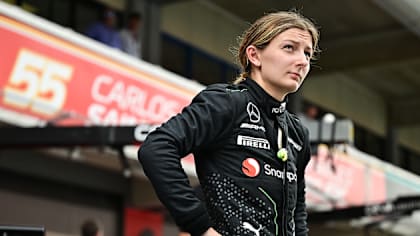
Technical
TECH TUESDAY: Most improved, best ‘bang for buck’ and more – it’s our 2021 star car awards

Share

Even with the regulation-imposed limitation of retaining the 2020 chassis into 2021, the teams invariably found ingenious ways of re-optimising these chassis around the regulation floor and diffuser/rear brake duct restrictions.
These met with varying degrees of success through what was a remarkable season, one in which Red Bull-Honda finally broke the domination of Mercedes in the hybrid era. But that was just the headline title battle. While there were fascinating technical tales to tell from those two teams, things were just as intense elsewhere.
TECH TUESDAY: The key developments that helped Mercedes win their 8th constructors’ title
MOST IMPROVED – Alfa Romeo C41
Although Alfa Romeo finished in a disappointing ninth place in the constructors’ championship, they made the biggest qualifying performance gain of any team, from 2.9% off the fastest in 2020 to just over 1.9% in ’21 – around 0.25% more than the next-most improved team.
There was a double whammy boost driving these numbers: the C41 was both more powerful and more aerodynamically competitive than its C39 predecessor. The power boost came from supplier Ferrari, from the very low base of 2020 when the Alfa was around 60bhp down to the rival Mercedes-powered Williams to only around half that deficit in ’21.
Aerodynamically, the key to the improvement was the replacement of the previous car’s wide nose with a new Mercedes-inspired slim nose and accompanying under-nose cape, which was much more effective at turning the airflow in the desired direction towards the barge boards. This is where the token spend was made.
TECH TUESDAY: How Red Bull and Honda cleverly transformed 2020’s RB16 into the title-winning RB16B
The front wing remained very distinctive in its heavy inboard-loading shape, but had a unique feature in addition to that: the mainplane’s underside was very flat and close to the ground, maximising the ground effect by running it so close to the track surface.
To control the resultant tendency to stall as the nose dipped under braking, there was a slot in the endplate which would suck the air through as it tried to stall, keeping the underside of the wing working.

Alfa's slot helped control the wing's tendency to stall
BIGGEST INTER-SEASON DEVELOPMENT – Red Bull and Ferrari
In evolving the RB16 into the RB16B, Red Bull made big changes despite the regulation limitations. Not only was it powered by a new Honda power unit which was smaller, more powerful and required less cooling, but there was a fundamental rethink on the rear suspension.
The lower rear wishbone was switched around to sweep rearwards, creating much more volume for the airflow in the sensitive area around the diffuser. This was achieved by re-purposing existing chassis mounting points and having a longer gearbox casing to mount the inboard rearward links to. The token spend went on the new gearbox.
TECH TUESDAY: How Ferrari's Mexico City brake experiment gave us a glimpse of F1's future
Ferrari did a remarkably similar thing, with a heavily uprated combustion chamber for the PU and the same sweeping back of the rear suspension. But in addition, Ferrari also used the opportunity of the new gearbox casing to move the differential slightly higher up in the chassis, creating yet more airflow volume around there, albeit at the expense of an increase in the centre of gravity height.
Red Bull’s average qualifying deficit to Mercedes reduced from 0.7% in 2020 to less than 0.1%, while Ferrari’s reduced from 1.4% to 0.7%.
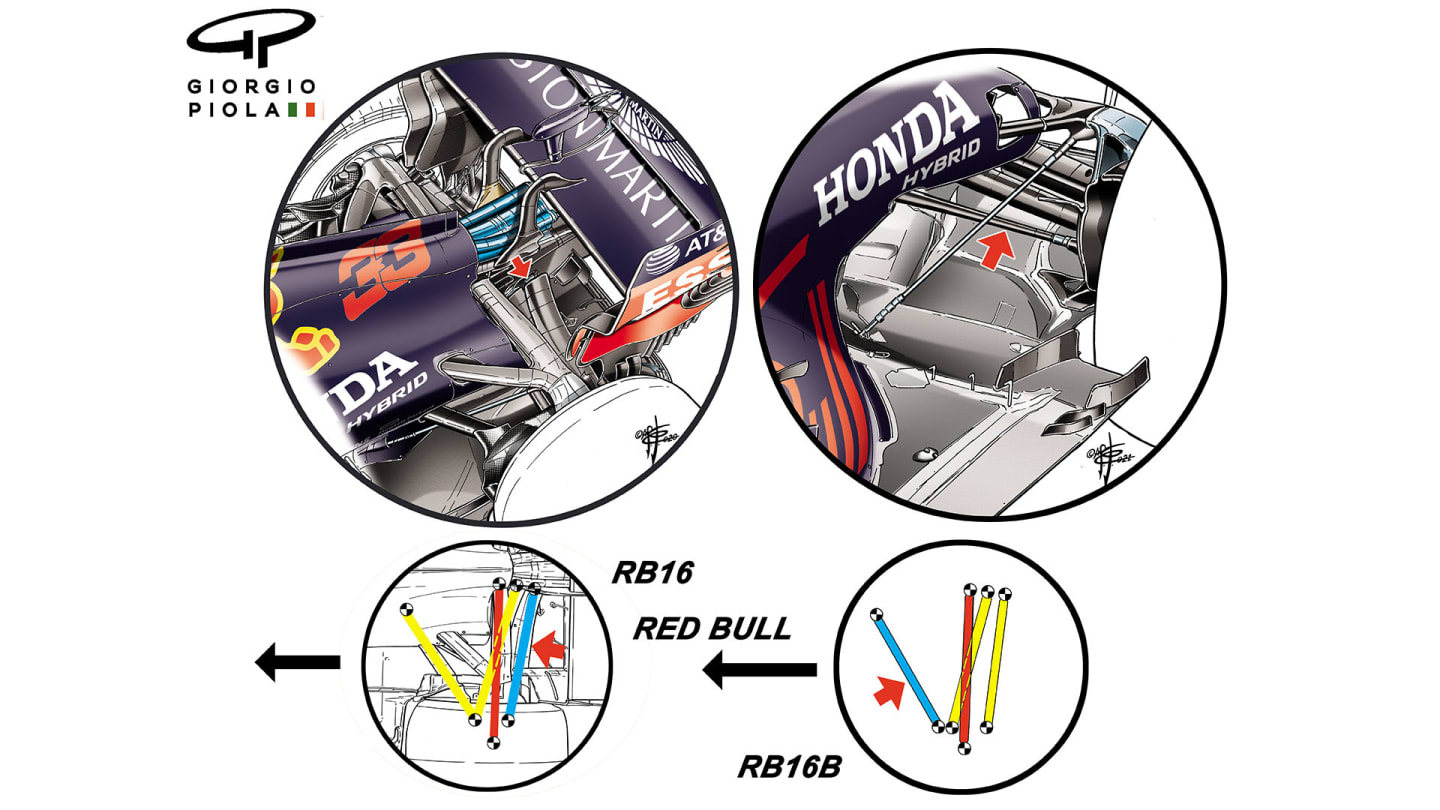
The differing rear suspension approaches of the 2020-spec RB16 in the top left circle, and the 2021-spec RB16B in the top right, with the mounting point changes shown underneath
BEST IN-SEASON UPGRADE PACKAGE – Mercedes W12, British Grand Prix
Mercedes completely changed the aerodynamic flow structures around the front of the W12’s chassis with their Silverstone upgrade. This diverted some airflow around the sidepods, changing the airflow to the underfloor in a way which made their diffuser stall much more powerful.
Once the rear of the car was forced down on its suspension by the building downforce as speed rose, so the diffuser’s angle to the track would become low enough that there was no longer a big enough difference in pressure between the air beneath the flat section of floor and that between the diffuser, stalling the diffuser and its upswept airflow to the rear wing’s underside.
READ MORE: Is Mercedes’ improved straight-line speed down to some clever ride-height engineering?
This would cancel a lot of drag, increasing the straight-line speed. It allowed Mercedes to use bigger wings and more rake into the season’s second half, clawing back their corner disadvantage to Red Bull while increasing their straight-line advantage.
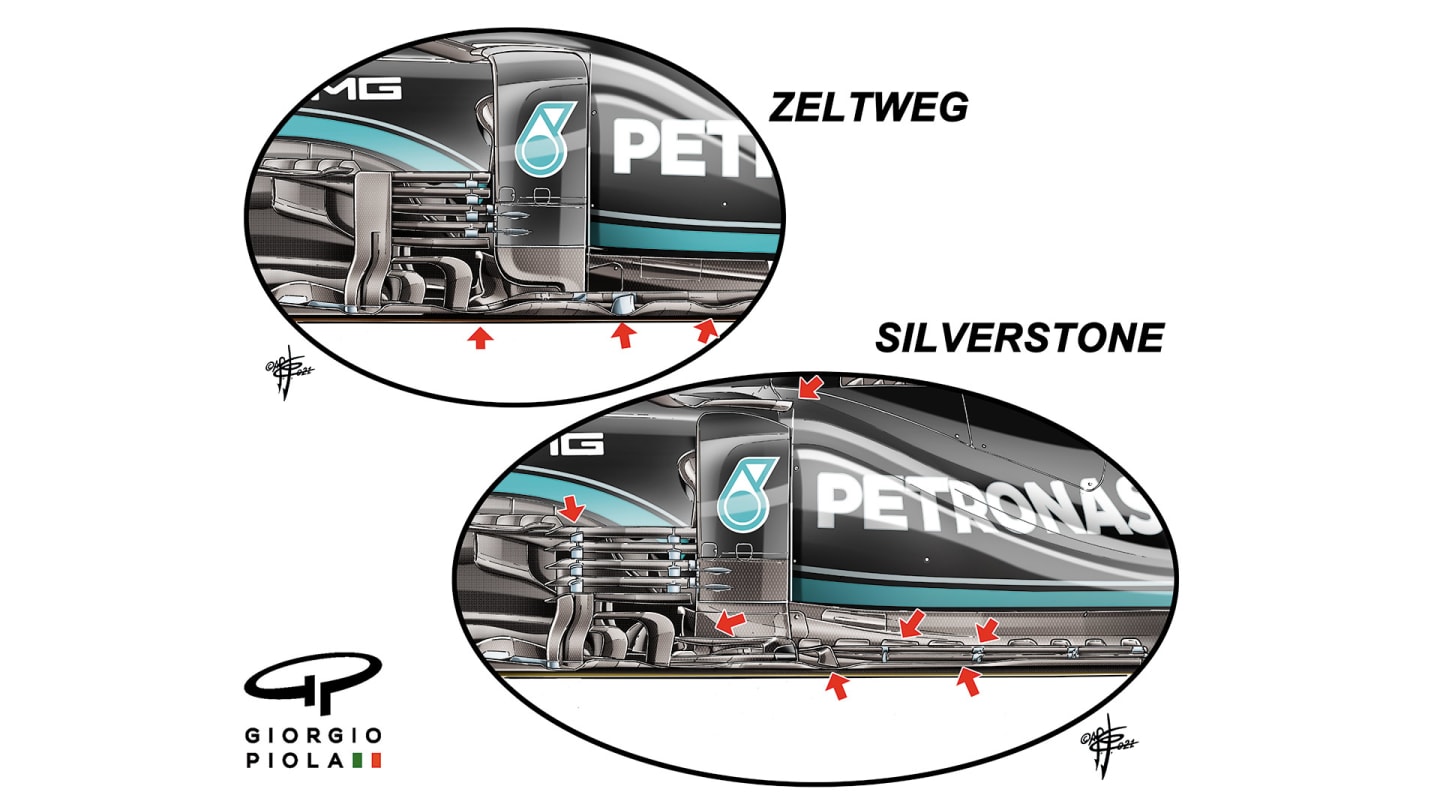
A comparison of Mercedes' Austrian GP bargeboard (above) and their Silverstone one (below)
BEST PERFORMANCE ‘BANG FOR BUCK’ – AlphaTauri AT02
AlphaTauri took a fully deserved sixth place in the constructors’ championship, as their AT02 model enjoyed the benefits of new slim nose aerodynamics (the token spend) and the upgraded Honda RA621 power unit.
Their qualifying average was remarkably close to Ferrari and McLaren, two vastly bigger teams. But they also made gains even on the much-improved Red Bull. In 2020, AlphaTauri had qualified an average of 0.9% slower than the frontrunning sister team, but this year that was reduced to 0.7%.
VOTE: What was your favourite race of 2021? It's time to pick the best Grand Prix of the season
Given that both cars enjoyed the same power unit upgrade, AlphaTauri actually found more from their front end aero changes (which Red Bull had already made in 2020) than Red Bull found from their reconfigured rear.
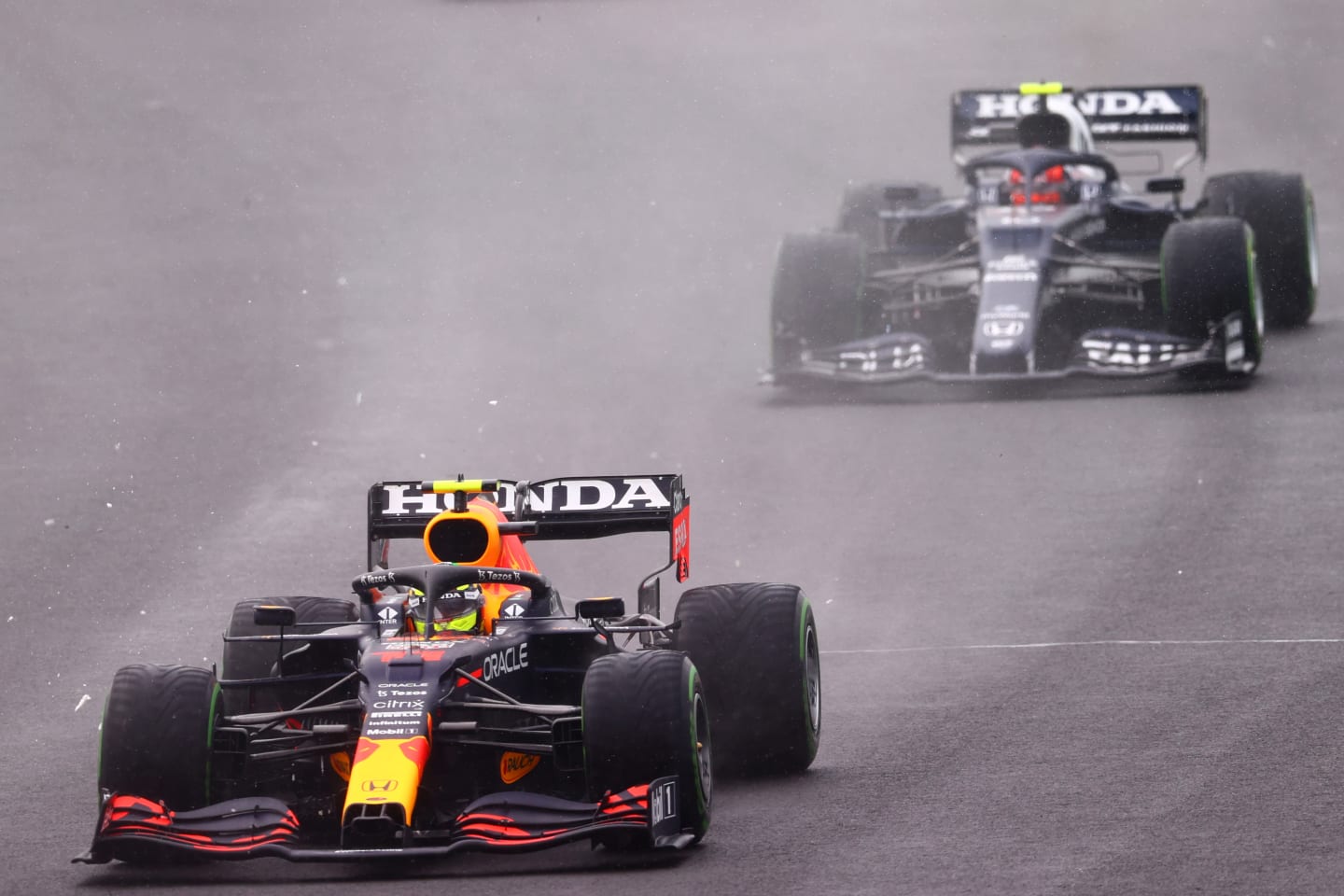
AlphaTauri found more from their front end aero changes than Red Bull found from their reconfigured rear end
BIGGEST SURPRISE – Williams FW43B
Although Williams remained on average only the ninth-fastest of the 10 cars (faster only than the Haas), there were times when the combination of circuit traits and weather conditions allowed George Russell to do remarkable things with it, putting it on the front row in Spa, row two in Sochi and P8 at Silverstone.
The key difference between this car and its predecessor was a new high cooling route for the radiators, which made for a bulkier engine cover but created space for a more extreme coke bottle shape in the rear lower chassis, enhancing the airflow speed down the side of the car and around the diffuser, which in turn increased the speed of the underfloor airflow.
EXCLUSIVE: George Russell’s emotional final day with Williams
The extreme coke bottle, in combination with the wide nose, meant the aerodynamics tended to be peaky and did not react well to windy conditions. But when the wind was still and the corners long, it could produce a lot of downforce.
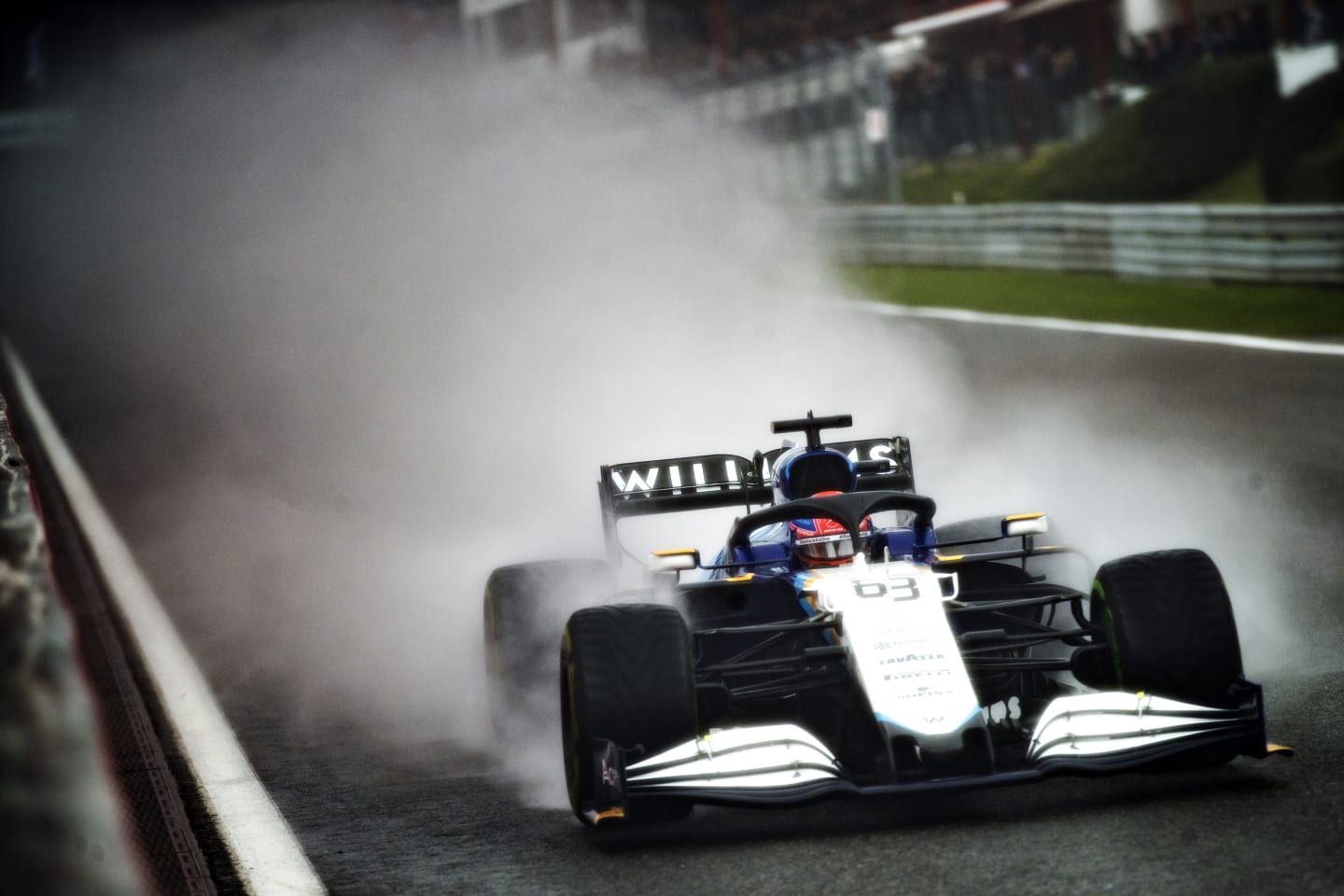
Williams’ changes – including a new cooling route and accompanying bulkier engine cover – helped Russell to take P2 on the grid in Spa
MOST ORIGINAL – McLaren MCL35M
McLaren’s reaction to the regulation snipping of the length of the vanes of the diffuser outside of the central area was effectively to make the central tunnel walls the vanes, which were therefore inside the central area – where the restriction did not apply.
It meant the diffuser worked over a narrower area than a conventional one but it clearly was very effective, as the McLaren vied with Ferrari as the third-fastest car and for third place in the constructors’ championship. Furthermore, at Monza they achieved a 1-2 in the race, the only team to score such a result all season.
REVEALED: F1’s team bosses choose their Top 10 drivers of 2021
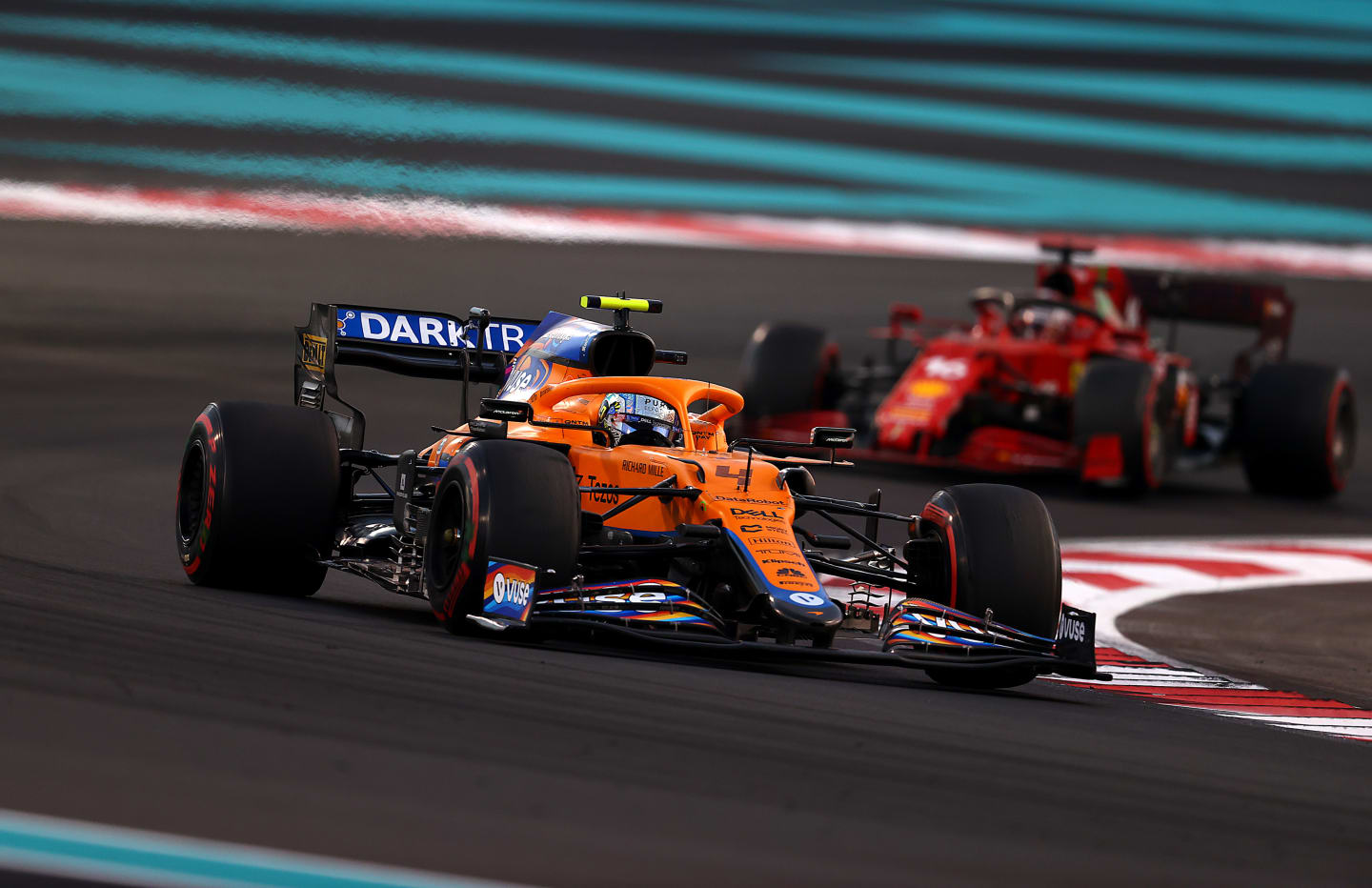
McLaren's unorthodox approach nearly netted them P3 in the constructors'
YOU MIGHT ALSO LIKE
News Doriane Pin to continue with Mercedes for 2025 F1 ACADEMY campaign
News Aston Martin ‘cannot be happy’ with 2024 season as team boss Krack insists they have ‘learned lessons’ for the future
News Pourchaire and Maloney set to leave Sauber Academy
News Oakes discusses 'trepidation' over becoming third Alpine Team Principal in 18 months

